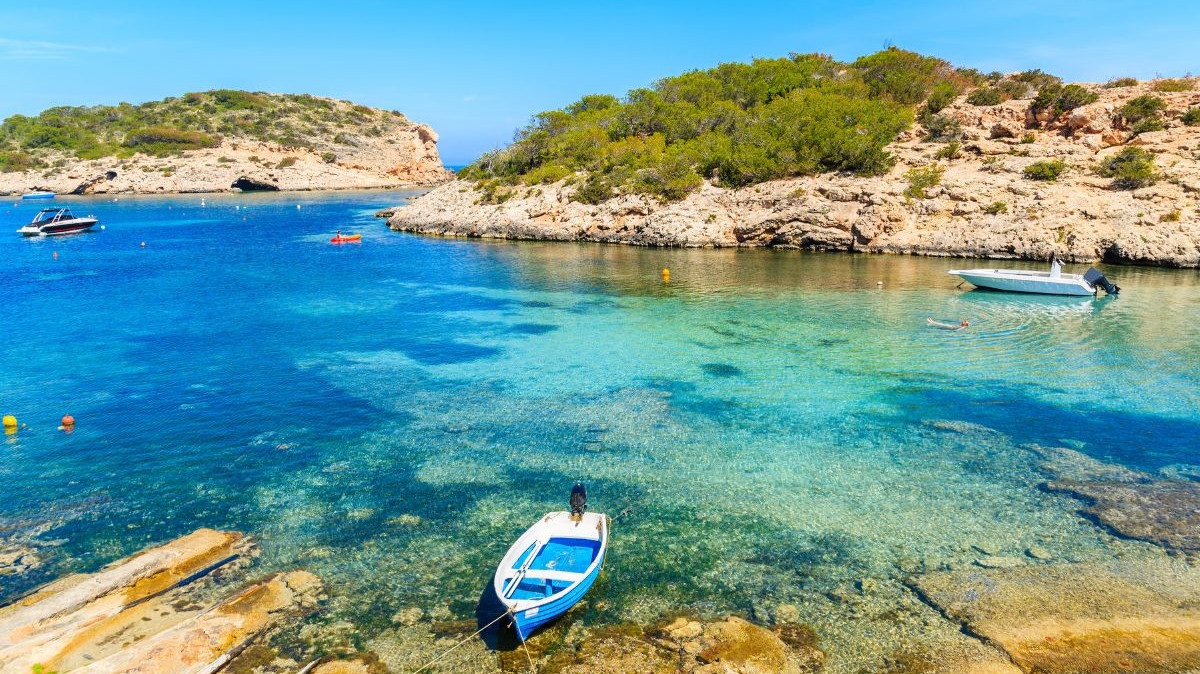I guide you off the beaten track in the most popular short-haul holiday destinations
Think of Mallorca and chances are you’ll have heard of party-centric Magaluf and family-filled Palma Nova.
Tenerife has its own equivalents in Playa de Las Américas and Los Cristianos; Ibiza boasts Playa d’en Bossa and San Antonio, while Cyprus has fun-fuelled Ayia Napa and ever-popular Protaras.
All these resorts have proven themselves to be die-hard crowd pleasers.
The neon-lit strips of bars, restaurants and clubs are all geared up to provide 24-7 hedonistic entertainment and to offer families easy, familiar and great-value surroundings.
For many (tens of thousands in fact) these resorts tick the box perfectly.
But for so many others, they want to get as far away from these places as they can!
Just a stone’s throw from these well-publicised beach resorts lie quiet villages, more remote beaches and towns oozing in culture.
Here you can have a more authentic experience - immerse yourself in the local traditions, sample the regional food and explore a destination away from the crowds.
So I want to throw the spotlight on to the lesser-known and authentic areas of the most popular mass-market holiday spots for Brits. I want to show you the other side.
So let’s go exploring off the beaten track.
Cyprus: swap Ayia Napa for the Troodos Mountains, Avdimou and Pissouri
Exploring this island is simple thanks to the fact that driving is on the left-hand-side of the road, as in the UK. Driving from east to west can be done in as little as three hours.
Leaving the popular coastal towns of Protaras, Ayia Napa, Larnaca, Limassol and Paphos behind, it’s really easy to find a plethora of quieter beaches and remote coves.
Avdimou village sits halfway between Limassol and Paphos yet is a world away. Alongside a glorious half-a-mile beach, the village itself is a perfect example of a traditional, serene Cypriot village dotted with a few restaurants and tavernas.
Although slightly more developed than Avidimo, Pissouri is a good base and gets the balance right between embracing tourists and maintaining its traditional character.
But it’s inland where you’ll discover the “real” Cyprus. In the beautiful Troodos mountains a host of unassuming villages remain unspoilt and steeped in tradition.
Platres, Troodos and Kakopetria are gems where the locals tend to reside. Even quieter is Pelendri and, despite its tiny size, there’s lots to explore. Here you’ll get the real taste of Cyprus in the tavernas and also in the town’s Tsiakkas winery.
Across this rural region, hiking trails criss-cross the mountains, leading you through olive groves and past medieval churches. Dating from as early as the 11th century, more than a dozen of these chapels are scattered around Mount Troodos.
Kykkos Monastery is one of the better-known spots, but if you have time to visit only one, Stavros tou Agiasmati, with its beautifully restored paintings, is our top pick.
And then you have the island’s capital, Nicosia. This city is teeming in history and culture and it happens to be the world’s last divided capital city. The Green Line separates the Republic of Cyprus from Northern Cyprus and you can still walk alongside the wall today.
Stay at: Petit Palais Boutique Hotel, Platres, Troodos
This small, unassuming boutique hotel is cosy and intimate. It was renovated in 2020 and offers an authentic Cyprian stay, with local cuisine served in the restaurant. It’s a mere 250 metres from the main square of Platres with its cafes and traditional tavernas.
Mallorca - Swap Magaluf for Deia, Villamosa, Soller and Palma
Mallorca is a stunning island. While the popular hotspots might be teeming with crowds and the streets lined with bars and clubs, you don’t have to go far to discover the true Mallorca.
The island’s capital, Palma, is a must-see with its impressive Gothic cathedral, La Seu, taking centre stage. Getting lost as you explore the narrow streets of the Old Town is all part of the fun. Here you’ll find charming courtyards, local boutiques and authentic tapas bars.
From here be sure to hop on the vintage wooden train and ride the track from Palma to the picturesque village of Sóller in the north of the island. Winding through the Tramuntana mountains, you’ll be rewarded with breathtaking views of olive groves, citrus orchards and rugged, rolling hills.
Sóller is a delightful village with a large square in the centre, flanked with tavernas and bars. The weekly Saturday market entices the locals to stock up on fresh produce, while the tourists can browse the stalls of local artisans.
Don’t get confused with the coastal town of Puerto Soller. There’s a tram line that links the mountain town of Soller to the port town of the same name. From its protected harbour, boats and fancy yachts are ready to take you out to enjoy the views along the rugged coast.
Further into the mountains even more glorious villages lie nestled. Deià has long been a haven for artists, writers and musicians and a stroll through its cobbled streets is an absolute delight.
Meanwhile, the hilltop village of Valldemossa is one of those ‘pinch me’ places – so picturesque it’s almost unreal. Its historic monastery, where composer Frédéric Chopin once stayed, is a former royal residence and still as regal. The village is also known for its charming stone houses, artisan shops and the delicious local pastry, coca de patata.
For those seeking tranquility, head to the northern coast and explore Cala Tuent or the Cap de Formentor, where dramatic cliffs meet crystal-clear waters (although take note: in the summer months access by car to Cap de Formentor is restricted).
In the south, Es Trenc beach provides a serene alternative to Mallorca’s crowded resorts, boasting powdery white sand and a relaxed, untouched atmosphere.
Stay at: Hotel Es Port, Puerto Soller
This historic and simply beautiful hotel is a converted 17th century fortified mansion. Sitting within manicured gardens, this property has a spa and two elegant restaurants, one located beside its pool. The hotel is situated within easy walking distance to Puerto Soller’s wonderful bay, complete with a sandy beach with a pedestrianised promenade dotted with cafés, restaurants and shops.
Tenerife - swap Los Cristianos for Garachico, Masca, Anaga and Taganana
While this ever popular Canary island attracts tourists by the plane load, so much of it remains untouched. It’s so easy to escape the crowds and explore the real Tenerife.
While on the sun-drenched south coast you’ll find the ever-popular resorts and a roll call of golden beaches, up in the north there’s a host of hamlets nestled in pine-clad valleys giving a glimpse into the island’s traditional life.
In the north west you’ll discover the remote village of Masca. The scenery here is breathtaking and once you’ve walked the village’s cobbled streets hike through the Masca Gorge. Your efforts will be rewarded when you reach the secluded beach and take a refreshing dip.
Also on your itinerary should be Garachico. Once a thriving port town, it was devastated by a volcanic eruption in 1706. Today, Garachico is a beautifully restored town with picturesque streets, traditional Canarian architecture, historic churches and the natural rock pools of El Caletón inviting you to dive right in.
Meanwhile, colonial La Orotava boasts grand mansions adorned with wooden balconies, such as the Casa de los Balcones, and landscaped gardens like the Jardines del Marquesado de la Quinta Roja. As you wander through the narrow streets, soak up the history and sample local delicacies such as gofio, a roasted grain flour that has been a staple of Canarian cuisine for centuries.
If you’re a nature lover, Anaga Rural Park is a must, offering some of the most spectacular scenery on the island. There are loads of well-marked trails leading through the woodlands and along rugged coastlines.
En route you’ll come across hidden hamlets like Taganana, surrounded by virgin beaches and rock formations rising out of the sea just off the coast – it’s the perfect spot for a seafood lunch.
Further west from Taganana at the foothills of the Anaga mountains is the surfing haven of Bajamar. The rugged – and sometimes wild – coastline is the town’s main draw. At high tide, waves crash spectacularly against its two huge seawater pools; during low tide, they all but disappear, leaving clear, calm waters perfect for swimming.
While most of these villages mentioned sit on the north of the island, for those choosing the sunnier south, authentic Tenerife is still easily reached.
Just half an hour’s drive from Los Cristianos – yet world’s away – is Vilaflor. Nestled in the mountains, 1,400 metres above sea level, Vilaflor is the highest village on the island, sitting in the shadows of Mount Teide. With a history dating back to the 16th century, Vilaflor still retains its traditional olde worlde charm.
Stay at: San Roque, Garachico
This adults-only retreat set in an 18th-century mansion in Garachico is a charming boutique property. It has an outdoor swimming pool and small spa. The restaurants and bars of the historic centre are within a few minutes’ walk. The hotel rents and stores bicycles allowing you to explore on two wheels.
Turkey - swap Marmaris for Bozburun or Datca peninsulas or Pattara
Turkey is awash with quaint places that showcase Turkish culture at it’s best and you don’t have to venture too far from the bustling holiday hotspot of Marmaris in the southwest to discover them.
Head south for just one hour and you’ll hit the Bozburun peninsula, awash with quaint villages, hiking trails and sandy bays. The beach at Kumlubuk is outstandingly beautiful. And close by is the small fishing village of Turunc where once you’ve explored the cobbled streets you can pull up a chair at a restaurant by the bay to enjoy the catch of the day.
Nearby is Orhaniye, renowned for its Kızkumu Beach, where you can seemingly walk on water along a submerged sandbar stretching into the bay. It’s a popular stop for boats to drop anchor and passengers to come ashore to dine on fresh seafood and traditional Aegean dishes in the host of restaurants hugging the harbour.
The peninsula is dotted with ancient ruins. Head to the far end to discover them in the villages of Söğüt and Taşlıca.
Adjacent to the Bozburun peninsula is the 50-mile-long Datça peninsula. Peppered with deserted beaches, ancient sites, olive groves and unspoilt villages, this peninsula has long been a go-to spot for well-heeled Istanbulites, yet it retains its rustic feel.
The busiest spot on this stretch is the coastal town of Datça which has lots of shops and waterfront bars but beyond that the area remain relatively untouched. Take a morning mooch through the cobbled streets of the hilltop village of Eski Datça.
A mere 30-minute drive from crowded Marmaris will see you arrive in Bohemian Akyaka. This is one of Turkey’s designated ‘cittaslows’ (slow towns). Hugging the banks of the Azmak river is a string of fish restaurants and by night its Blue Flag beach becomes a veritable cocktail bar with restaurant tables set up on the sand.
Admittedly a little further from Marmaris, but so worth the three-hour drive, you’ll discover Patara. Home to an awe-inspiring archaeological site dating back to the Lycian era, you can explore the ruins of the grand city, including the imposing Roman amphitheater, intricately carved Lycian tombs and the ruins of the city's ancient market.
However, Patara is probably most renowned for its glorious 12-mile soft, sandy beach. Between May and October, chances are high that you’ll witness the nesting or hatching of turtles.
Stay at: Loryma Resort, Turunc
Perfectly placed for hiking in the mountains, Loryma is a great getaway set within lush pine forests and olive groves. Although some rooms offer self-catering facilities, the hotel prides itself on using the freshest, locally-sourced ingredients at its restaurants, with meals served al fresco overlooking the Aegean Sea. There's plenty of things to do here including yoga, hikes and visits to the hotel spa. The hotel also organises regular shuttle buses to the beach.
Ibiza - swap Playa D’en Bossa for Portinatx and Cala Xarraca
This island has gained itself a reputation for hosting some of the world’s most glamourous beach parties and being home to world-class nightclubs and world-famous DJs. Yet, the party scene is only a very small part of this otherwise laidback island.
Away from the likes of Playa d’en Bossa and San Antonio, Ibiza has a quieter, more authentic side where you swap your dancing shoes for walking boots or, even better, bare feet.
Head to the island’s northern and western regions for wild coastal walks through lush pine trees leading to beautiful beaches and coves. Two gems are Cala Xarraca to Cala Xuclar, both linked by a three-mile walking trail through the woods.
At the northern-most part of the island you’ll find Portinatx, a quiet, beach town with a great selection of laid-back bars and authentic tavernas. Every Sunday the town is full of artisans setting up stall for the weekly Hippie Market selling floaty dresses, handmade jewellery and all manner of accessories.
One of the most photogenic spots in Ibiza is Cala d’Hort, hidden away in a national park. This idyllic spot is best known for its views overlooking the magical rocky island standing 400 metres tall.
Lesser known, but certainly not less beloved, is the Ses Salines Natural Park. Here you’ll accompanied by strolling pink flamingoes as you discover the area’s pristine white salt lakes. There are various hiking trails in the park with the one-and-a-half-hour hike from Cala Salada Beach to the Ses Fontanelles cave being one of the best. The views over the rugged coast are stunning, and at the cave, you can dive into its crystal-clear water.
If you can bear to leave the sandy beaches, we urge you to head inland where a whole host of hidden gems await.
Long a hub for artistic types from across the continent, Santa Gertrudis de Fruitera, sits smack bang in the middle of the island. Even today it retains its bohemian vibe.
Overlooked by a whitewashed fortress church, the main square is the heart of the town where you’ll find lots of craft shops, art galleries and bars. Don’t miss Bar Costa, where penniless artists used to swap paintings for food.
Stay at: Grupotel Ibiza Beach Resort, Portinatx
This property sits cocooned within the pine forest in the northern town of Portinatx. From its hilltop position it overlooks the horseshoe-shaped bay. Steps from the hotel lead down to sandy S’Arenal Petit Beach. In the town you’ve got a wonderful selection of seafood restaurants and bars. Just like Portinatx itself, this adults-only hotel has the chill-out formula down to a T.
Costa Blanca, Spain - swap Benidorm for Javea, Calpe, Denia and Altea
Benidorm - it’s been a favourite among Brits for decades, flocking there in droves for its beer, beaches and bingo. But, not so far away from its skyscrapers lies a whole different world.
Just a few miles up the coast you’ll reach Denia with its impressive 11th-century castle, authentic tapas bars and traditional Spanish markets. Incidentally, you can also take a ferry from here to explore the Balearic Islands.
And if you venture inland from here you’ll find the gorgeous Vall de Gallinera valley, peppered with unspoilt villages such as Benirrama, Benialí and Benissivà.
Pull up a chair in any of the tavernas and savour a taste of the real, local cuisine. How about blat picat, a local one-pot stew with cooked meats and chickpeas, or minxos, a tantalising blini-style wheat pancake filled with a mix of local wild herbs.
In June, this whole valley celebrates the harvesting of the cherry trees with a massive street party, markets, craft fairs and a street parade when all the locals come dressed in traditional costumes.
Further inland, hidden gems hide among the vineyards and olive groves. The medieval town of Benissa is steeped in tradition. At the end of June and beginning of July, like many other towns in Spain, Benissa celebrates its annual Moros y Cristianos (Moors and Christians) Festival when locals parade through the narrow, winding cobbled streets dressed in medieval costume.
Back down to the coast, literally a 15-minute drive from Benidorm, is one of the most beautiful towns on the Costa Blanca, Altea. Known for its whitewashed houses, blue-domed church and artistic vibe, Altea is an old town that is brimming with boutiques, art galleries and cosy cafés.
Continuing to hug the coast you’ll soon reach Calpe, known for its striking Peñón de Ifach rock. This old town oozes traditional Spanish charm. Wander through its cobbled streets, admire the colourful murals, and visit the historical Torreó de la Peça (a fort built into the old walls that once enclosed the town).
Meanwhile, the well-heeled make a beeline for the town of Moraira. Over the years this coastal town has earned itself a more upmarket reputation – and this is reflected in the quality of the restaurants and shops here. The beach of El Portet is in walking distance and is favoured by the Spaniards.
A picturesque coastal town of Jávea is little more than a 30-minute drive from here. With a charming old quarter, Jávea offers a perfect blend of history and culture. A stroll through its narrow streets lined with whitewashed houses will soon bring you to the Church of San Bartolomé. The town’s port area also has a lovely promenade with excellent seafood restaurants, far removed from the touristy buzz.
Stay at: Villa Marquesol, Moraira
This three-bedroom villa has its own private pool and is fully equipped to provide a home-from-home just a short drive from characterful Moraira and Javea, with their sandy beaches, local restaurants and shops. The mountain and countryside views complete the perfect package at Villa Marquesol.
The Algarve - swap Albufeira for Carvoeiro, Salema and Cabanas da Tavira
It might be hard to believe when you’re running the beer-fuelled gauntlet on Albufeira’s famous Avenida Francisco Sá Carneiro – known locally as 'The Strip’ – that not so far away lie serene coves, lakes dotted with flamingos, tiny villages and remote forested trails.
Literally less than 40 minutes west of this hotspot a string of charming villages await, starting off with the fishing village of Carvoeiro. Further along the coast you’ll reach Burgau before reaching Salema. Salema is a great starting point if you enjoy hiking along rugged coastal paths.
Close by is Benagil Cave, possibly the most famous natural attraction in the Algarve following a social media post that went viral. This huge sea cave with a hole in the ceiling and doors that open up directly in the sea definitely deserves a place in your Portugal bucket list – but beware, it can get very busy.
If you want caves without the crowds then around Alovr’s coast – near Praia de Boião – are some tremendous caves. However, you’ll need to snorkel into some of these caves rather than kayak like at Benagil.
To the east of Albufeira you’ll arrive at Cabanas da Tavira, a charming beach town located near the idyllic city of Tavira. Nestled on a lagoon at the entrance to the Ria Formosa Natural Park, Cabanas is a true paradise for nature lovers. Yes, it has a lively central strip of bars, cafes and shops that hug the lagoon, but it’s still full of charm (and good taste).
From here you can take a short boat ride to the stunning Ilha de Cabanas island beach. With over four miles of pristine sand and crystal-clear waters, this beach is never too crowded, even during peak season. But the real draw of Cabanas is its incredible biodiversity. The Ria Formosa Natural Park is home to an astonishing array of bird species, including elegant flamingos.
Inland lie delightful, virtually untouched villages. Monchique is one of these hidden gems. Wander through its narrow streets and admire the beautiful coloured houses, tiled murals and various sculptures dotted around the town.
The village of Alte is equally charming. Watermills and small canals make for a great picnic area, as does a visit to its two springs. The tranquility and the glorious countryside views are a world away from the hustle and bustle in Albufeira.
Stay at: Vila Gale Albacora, Tavira
The old houses, workshops and warehouses of this former fishermen’s settlement have been turned into a charming eco hotel. It’s only a 15-minute drive from Faro Airport and a stone’s throw from the calm and sandy stretches of Praia dos Tesos.
A boat taxi departs from the hotel’s pier to the beautiful beaches of Tavira’s Island, which is a few hundred metres off the coast. The village of Luz de Tavira is a short drive away and you’ll find lots of places to eat and drink there - although the hotel has several restaurants. It also has an outdoor pool, kids pool and kids’ club (located in the former school house).
Ready to roam?
Have I whetted your appetite to explore beyond the tourist hotspots? Hopefully I have shown you that there’s a whole new world beyond these reputable resorts.
There are so many secret gems out there – and with my/our network of expert suppliers – I know exactly where they’re hidden. I'll happily guide you off the well-trodden paths, allowing you to discover the lesser-known spots within the most popular destinations.
I'll help you unveil the right spot for you. And don’t forget, I can help you with car hire too, enabling you to explore with ease.
And even better, I don’t charge you a penny for our service! So what’ve you got to lose?
Get on touch today and you’ll soon be venturing far from the madding crowd.















![[[+tv.holiday.alttext]]](https://cdn.notjusttravel.com/media/medium/uploads/c5/c5a3f85ec69676b64c725a411a08ec59a4a629c6.jpg)
![[[+tv.holiday.alttext]]](https://cdn.notjusttravel.com/media/medium/uploads/e1/e117b02ecbdb9274721fddb37c6a34735ccfd707.jpg)
![[[+tv.holiday.alttext]]](https://cdn.notjusttravel.com/media/medium/uploads/ed/ed892094ad952ecfe5f1b3f2f13baf00ffac3ad2.jpg)
![[[+tv.holiday.alttext]]](https://cdn.notjusttravel.com/media/medium/uploads/f1/f1c811518ae24395b0f02621e701667f473ff48d.jpg)
![[[+tv.holiday.alttext]]](https://cdn.notjusttravel.com/media/medium/uploads/7c/7c3d42e6fcc9dca485ea05c01c3bd5a7fd5c4db2.jpg)
![[[+tv.holiday.alttext]]](https://cdn.notjusttravel.com/media/medium/uploads/b2/b22ef62f2c671987344f832b23de843b1396d125.jpg)










